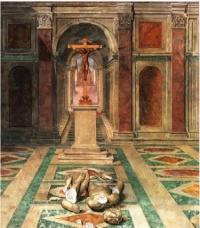Triumph of Christianity
From The Art and Popular Culture Encyclopedia
| Revision as of 15:46, 7 May 2013 Jahsonic (Talk | contribs) ← Previous diff |
Revision as of 15:50, 7 May 2013 Jahsonic (Talk | contribs) Next diff → |
||
| Line 3: | Line 3: | ||
| ''[[Triumph of Christianity]]''[http://commons.wikimedia.org/wiki/File:0_Triomphe_du_christianisme_-_Sala_di_Costantino_-_Vatican.JPG] (also known as '''Triumph of the Cross''') is a [[ceiling painting]] in the [[Sala di Constantino]], one of the [[Raphael Rooms]] in the [[Apostolic Palace]], painted by [[Tommaso Laureti]] (1530-1602). Images like this celebrate the [[destruction]] of ancient [[Paganism|pagan]] culture and the [[victory]] of [[Christianity]]. The painting depicts an ancient statue of the god [[Mercury (mythology)|Mercury]] lying broken on the ground. | ''[[Triumph of Christianity]]''[http://commons.wikimedia.org/wiki/File:0_Triomphe_du_christianisme_-_Sala_di_Costantino_-_Vatican.JPG] (also known as '''Triumph of the Cross''') is a [[ceiling painting]] in the [[Sala di Constantino]], one of the [[Raphael Rooms]] in the [[Apostolic Palace]], painted by [[Tommaso Laureti]] (1530-1602). Images like this celebrate the [[destruction]] of ancient [[Paganism|pagan]] culture and the [[victory]] of [[Christianity]]. The painting depicts an ancient statue of the god [[Mercury (mythology)|Mercury]] lying broken on the ground. | ||
| - | The fresco is in the largest of the four Raphael Rooms, the ''Sala di Costantino'' ("Hall of Constantine"). Its paintings were not begun until [[Pope Julius]] and indeed, [[Raphael]] himself had died. The room is dedicated to the [[victory of Christianity over paganism]]. Its frescoes represent this struggle from the life of the Roman Emperor [[Constantine I (emperor)|Constantine]], and are the work of Giulio Romano, Gianfrancesco Penni and Raffaellino del Colle. Because they are not by the master himself, the frescos are less famous than works in the neighboring rooms. Continuing a long tradition of flattery, Raphael's assistants gave the features of the current pontiff, [[Clement VII]], to [[Pope Sylvester I|Pope Sylvester]] in the paintings. | + | The fresco is in the largest of the four Raphael Rooms, the ''Sala di Costantino'' ("Hall of Constantine"). Its paintings were not begun until [[Pope Julius]] and indeed, [[Raphael]] himself had died. The room is dedicated to the [[victory of Christianity over paganism]]. Its frescoes represent this struggle from the life of the Roman Emperor [[Constantine I (emperor)|Constantine]]. |
| == See also == | == See also == | ||
Revision as of 15:50, 7 May 2013

|
Related e |
|
Featured: |
Triumph of Christianity[1] (also known as Triumph of the Cross) is a ceiling painting in the Sala di Constantino, one of the Raphael Rooms in the Apostolic Palace, painted by Tommaso Laureti (1530-1602). Images like this celebrate the destruction of ancient pagan culture and the victory of Christianity. The painting depicts an ancient statue of the god Mercury lying broken on the ground.
The fresco is in the largest of the four Raphael Rooms, the Sala di Costantino ("Hall of Constantine"). Its paintings were not begun until Pope Julius and indeed, Raphael himself had died. The room is dedicated to the victory of Christianity over paganism. Its frescoes represent this struggle from the life of the Roman Emperor Constantine.
See also
- Raphael_Rooms#Sala_di_Costantino
- Christianity and Paganism
- Christianization
- Early Christianity
- History of Christianity
- Triumphalism

